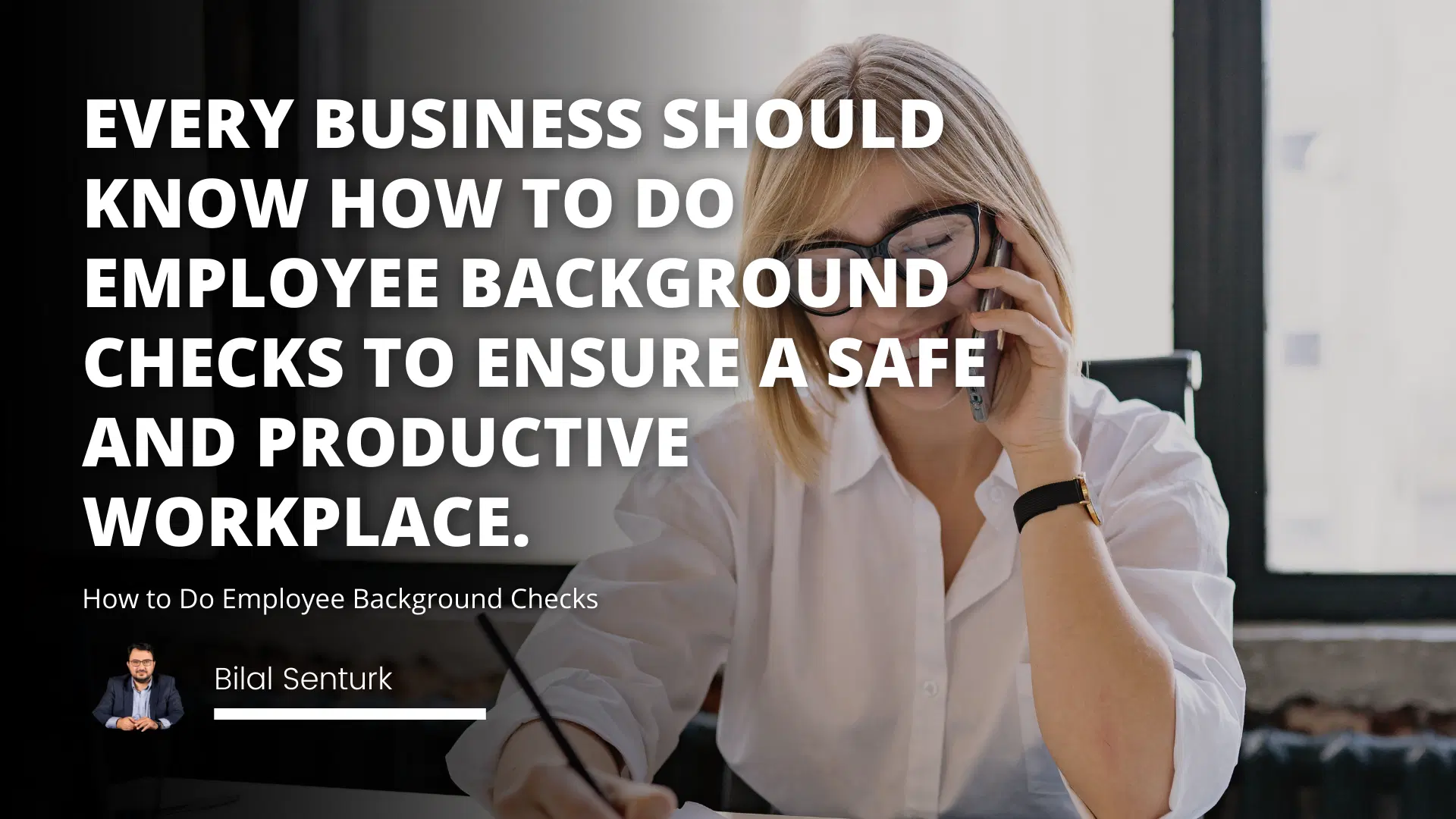
Are you thinking of hiring a new employee? If so, it's essential to do a background check before making any final decisions. By checking out your potential employee's history, you can avoid bringing on someone with a criminal record or known for bad behavior.
There are several ways to conduct a background check, and in this blog post, we'll show you the best methods for doing so. Keep reading to learn more!
How to do a background check on an employee (or anyone) in 7 easy steps
No one is exempt from a background check. Whether you're a potential employee looking for a new job or someone who wants to know more about your new neighbor, doing a background check is essential in protecting yourself and those around you.
This blog post will outline the steps you need to take to do a background check on anyone, anywhere. Let's get started!
1 - What is a background check, and what information can it reveal about an employee?
A background check is a screening process that employers may use to verify information about a potential employee's past. This can include job history, criminal record, credit score, or other information. Background checks can help employers to feel more confident about their hiring decisions, and they can also help to protect the workplace from potential hazards.
For example, an employee with a history of violence may threaten other employees, and an employee with a poor credit score may be more likely to steal from the company. However, it is essential to remember that background checks are not perfect; they can sometimes reveal inaccurate or incomplete information.
As such, employers should use background checks as part of the hiring process rather than relying on them exclusively.
Workforce Segmentation: A Strategic Approach for Business Success
Workplace Harassment: Effects, Legal Issues and Prevention Strategies
360-Degree Feedback: An In-depth Analysis of Its Implications & Impact
Protect the safety of employees
Reduce the risk of hiring someone with a criminal history
Verify an employee's credit score
Detect potential workplace hazards
2 - How do you conduct a background check on an employee, and what are the best resources for finding this information?
There are a few different ways to conduct a background check on an employee. One standard method is to use a third-party service, such as SterlingBackcheck or GoodHire. These companies will collect information from public records and other sources to create a report for you.
Another option is to do a DIY background check using online resources such as Google, LinkedIn, and Facebook. However, remember that this method may be less reliable, as it can be easy to find inaccurate information online.
Get a complete and accurate picture of an employee's background
Conduct checks quickly and easily
Protect your business from potential harm
Verify information before making a hiring decision
3 - What are the potential risks of conducting a background check on an employee?
While background checks can help make hiring decisions, there are also some potential risks.
First, background checks can sometimes reveal sensitive information about an employee, such as medical conditions or financial troubles. Additionally, if an employer uses a third-party service to conduct a background check, the employee may be charged a fee for this service.
Finally, there is always the possibility that a background check will turn up false positives, which could lead to discrimination against the employees in question.
Protect your business by ensuring you're hiring the best possible employees
Get detailed information about an employee's history and criminal record
Avoid potential lawsuits and financial damages caused by negligent hiring
Ease your mind and make confident decisions about who to hire
4 - How can you protect yourself from potential lawsuits if you don't conduct a background check on employees?
Most employers know it's important to conduct background checks on potential employees. Not only does this help to ensure that the people you're hiring are qualified for the job, but it also protects you from liability if something goes wrong.
However, many employers don't realize that there are steps you can take to protect yourself even if you don't conduct a background check. For example, it's essential to have a clear policy in place regarding the use of social media. If an employee posts something that could be construed as harmful to the company, you could be held liable if you didn't take steps to prevent it.
Additionally, you should ensure that your employees understand your policies and procedures and sign a document confirming that they've read and understood them. By taking these precautions, you can help to protect yourself from potential lawsuits.
• Protect yourself and your company from potential lawsuits
• Have a clear policy in place regarding social media use
• Make sure employees understand company policies and procedures
• Sign a document confirming employee understanding
5 - What should you do if you find information that suggests an employee is not suited for the job?
If you find information during a background check that makes you question whether or not an employee is suited for the job, it's essential to take action. First, you should talk to the employee in question and give them a chance to explain the situation.
If you're still not convinced they're suitable for the job, you may need to let them go.
Additionally, it's essential to document everything so that you can protect yourself in the event of a lawsuit.
Background checks can help employers to feel more confident about their hiring decisions and they also protect the workplace from potential hazards.
However, it's essential to be aware of the potential risks associated with background checks and to take steps to protect yourself from potential lawsuits.
Verify information about potential employees
Feel more confident about your hiring decisions
Protect the workplace from potential hazards
Document everything for legal protection
6 - How can you use background checks as a tool for employee retention?
Background checks can also be a tool for employee retention. For example, if you find that an employee has a history of job-hopping, it may be a good idea to conduct a background check before offering them the position.
This will help you verify their employment history and ensure that they are likely to stick around for the long term. Additionally, if you have an employee up for a promotion, you may want to conduct a background check to verify their qualifications.
By using background checks as a tool for employee retention, you can help ensure that your workplace is staffed with qualified and reliable employees.
Background checks can help to identify employees who are likely to job hop
Background checks can verify an employee's qualifications for a promotion
Background checks can help to maintain a safe and secure workplace
7 - What are the best practices for conducting background checks on employees?
There are a few best practices that you should follow when conducting background checks on employees. First of all, you should ensure that you have a clear and consistent policy regarding who will be subjected to a background check.
Additionally, you should give employees ample time to provide information about their past, and you should allow them to explain any negative information. Finally, you should make sure that your policies and procedures are well documented so that you can protect yourself in the event of a lawsuit.
Protect your business with well-documented background check policies and procedures
Follow a clear and consistent policy for who will be subject to a background check
Give employees ample time to provide information about their past
Allow employees to explain any negative information that is found
In conclusion, background checks are essential for employers to make informed decisions about who they hire. Following the best practices outlined in this article, you can protect yourself from potential lawsuits and find information that will help you retain your employees. Join our human resources course today if you're interested in learning more about conducting background checks.

Frequently Asked Questions
How can you tell if an employee is lying about their qualifications or experience?
While verifying an employee's qualifications and experience is always essential, some red flags indicate that an individual may lie about their credentials. For example, if an applicant's resume contains discrepancies or gaps, it may be worth taking a closer look. In addition, if an individual's story changes from one interview to the next, or they cannot provide specific details about their previous work experience, this could be cause for concern. Another sign that an employee may be lying is if they seem overly rehearsed or evasive when answering questions. If you suspect that an employee is not being truthful about their qualifications, it is essential to take the time to verify the information they have provided. Otherwise, you could make a hiring mistake that costs your business dearly.
What are the most important things to look for when screening potential employees?
When screening potential employees, it is essential to look for several qualities. First and foremost, you want to ensure that the candidate has the necessary skills and experience for the job. However, hard skills are not the only important thing to consider. You also want to look for candidates who are adaptable and good at problem-solving, as these qualities will be essential in meeting the challenges of the job. Furthermore, you want to find reliable employees who will show up to work on time. Finally, looking for candidates who are pleasant to work with and who will be a positive addition to your workplace is also essential. Considering all of these factors, you can help ensure that you find the best possible employees for your business.
Are there any specific red flags you look for during a background check?
When conducting a background check, several red flags indicate a person may not be a good candidate for the job. For example, a history of criminal activity, especially violent crime, is a major red flag. A candidate with drug use or excessive alcohol consumption record may also be considered unsuitable for the job. Additionally, financial problems such as bankruptcy or a history of not paying bills on time can also cause concern. Finally, candidates who have repeatedly changed jobs or have gaps in their employment history may also be viewed as less than ideal candidates. While not everyone with one or more of these red flags will necessarily be unsuitable for the job, they are causing further investigation.


